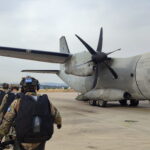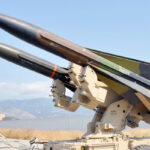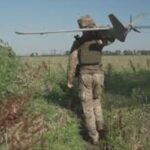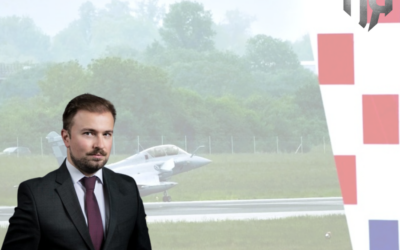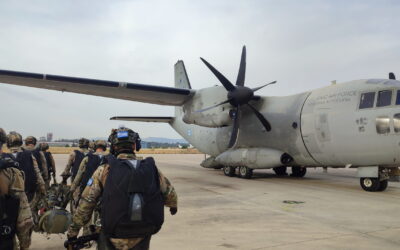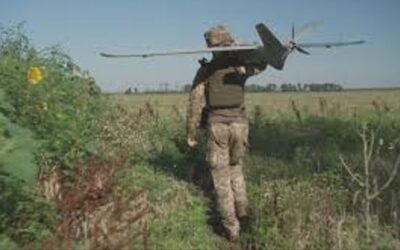It has only been a few months since Croatia started receiving the first of the Rafale fighter jets it ordered from France.
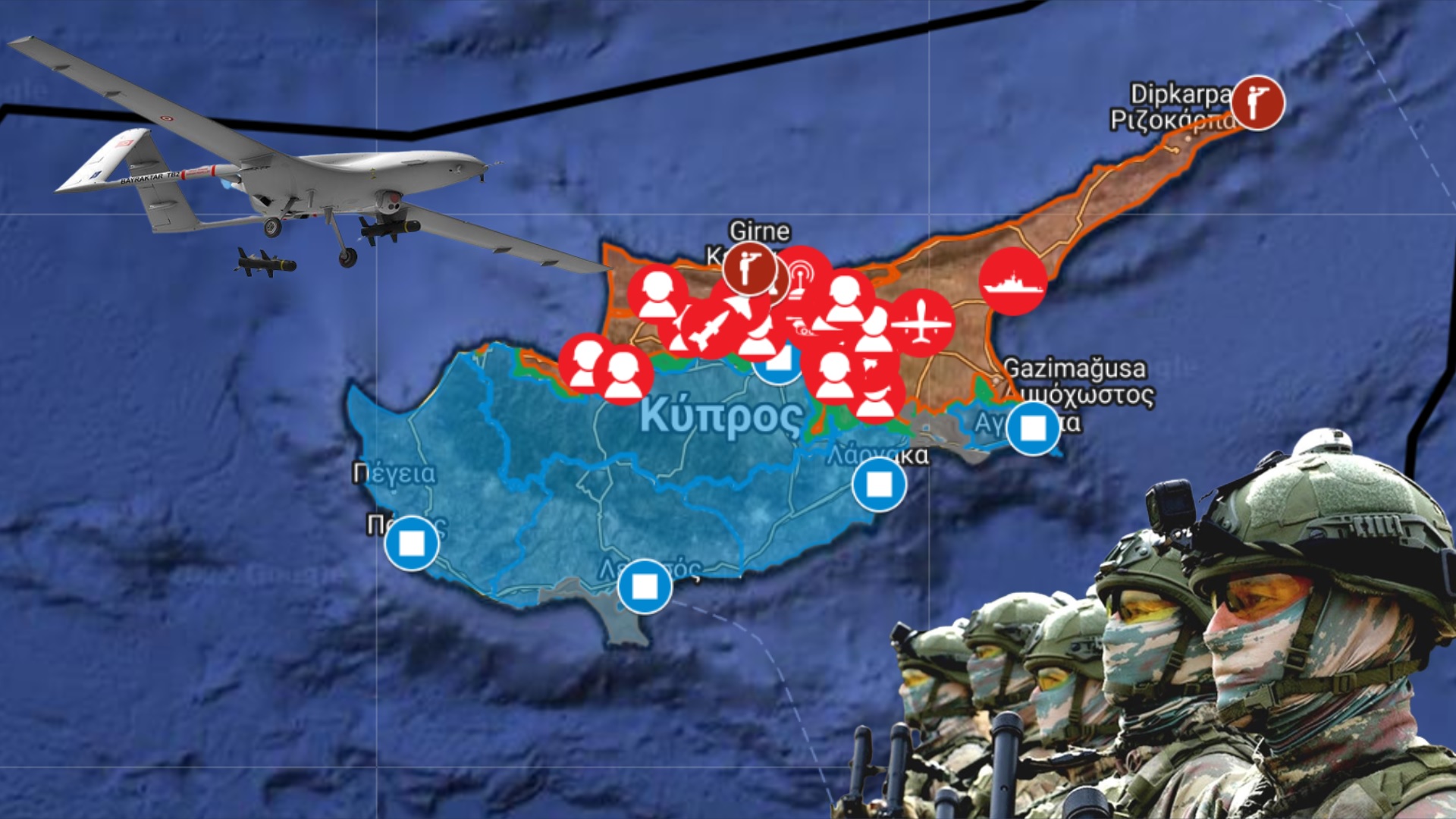
Andreas Pogiatzis*
A brief historical review was deemed necessary before the reader peruses the information on the Turkish Occupying Forces in order to better understand Ankara’s age-long expansionist policy towards Hellenism.
Brief historical review
The Turkish policy of questioning and claiming at the expense of Greece and Cyprus was launched in the 1970s and until today it aims to change the territorial status quo. The central pillar of Turkish claims is the Lausanne Peace Treaty, as well as the legal regime in the sea and air space that stems from International Law and especially the law of the sea (UNCLOS), a convention Turkey is always contesting, albeit this was never signed by Ankara.
This policy of questioning and claiming emerged in 1973 with the first claims against the Greek continental shelf, while after the invasion of Cyprus in 1974 the first questioning of the size of the Greek national airspace took place.
Greek-Turkish relations intensified due to Ankara’s ever-increasing disputes and claims, culminating in the March 1987 crisis and the Imia crisis in January 1996.
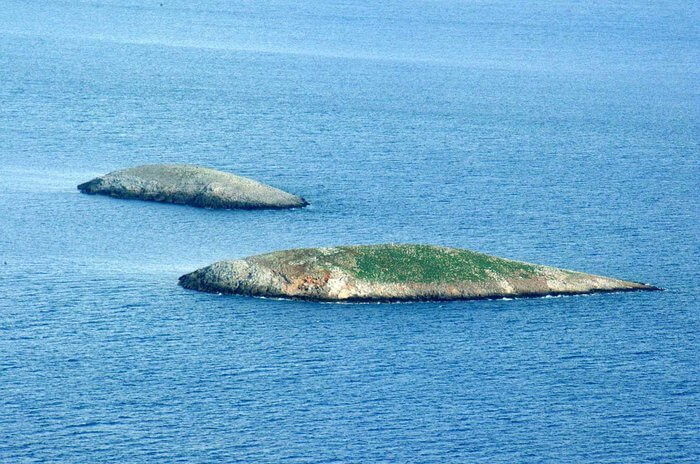 Mikri(Eastern) and Megali (Western) Imia
Mikri(Eastern) and Megali (Western) Imia
Since 1973, the growing Turkish disputes/claims include, among other things, the demand for the demilitarization of 16 islands of the Eastern Aegean, practically promoting methods contrary to the fundamental principles of the United Nations Charter. These practices or methods include threats of war, continuous violations of national airspace with or without armed aircraft and flights over inhabited islands.
The Treaty of Lausanne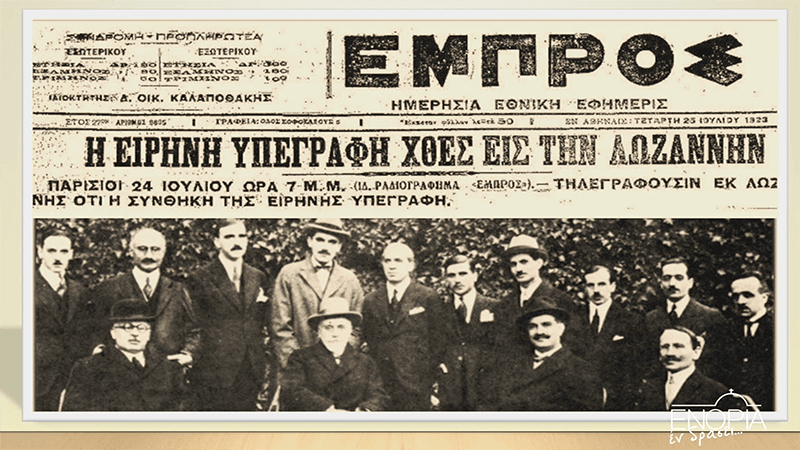 Excerpt from a newspaper of the time
Excerpt from a newspaper of the time
The most important articles of the treaty concerning Cyprus are articles 16, 20 and 21, which provide, inter alia, that Turkey renounces all rights and titles to territories located outside the borders defined by this treaty, including Cyprus (Article 16).
On July 20, 1974, Turkey, under the pretext of a coup against Archbishop (and President of the Republic of Cyprus) Makarios III, invaded Cyprus, violating every rule of international legality, including the Charter of the United Nations.
This first phase of the Turkish invasion was followed by a second one during which the city of Famagusta was captured. Turkey placed more than 36% of the territory of the Republic of Cyprus under illegal military occupation, which it still holds today.
Also read: Turkish soldiers open fire on Greek-Cypriots civilians – One person hospitalized
Ankara’s goal was also to change the demographics in occupied Cyprus, in order to ensure the compliance of the Turkish Cypriot leadership with the policy of the Turkish government. Further, with the immense emigration of Turkish Cypriots from the occupied territories, the total number of Turkish soldiers and settlers is now, according to sources, greater than the remaining Turkish Cypriots.
The Turkish Occupying Forces depicted on an Interactive Map
In this article, the Turkish Occupying Forces will be briefly presented with an interactive map depicting the positions of the main Command Centers as well as their critical infrastructures. The information mentioned in this article comes from open sources (OSINT) and may vary according to changes that might occur.
The areas controlled by the Republic of Cyprus are under the threat of powerful military forces that, on the one hand, have the ability to launch offensive actions and gain potential advantages within a short period of time and, on the other hand, exercise psychological threat against the Hellenism of Cyprus to serve Turkey’s political goals. On the contrary, a significant number of positions of the Turkish Occupying Forces are within the range of the National Guard’s artillery due to their forwarded position. The modern 155mm self-propelled howitzers of the National Guard have a range that usually exceeds 30 kilometres.
The Treaty of Peace signed in Lausanne, Switzerland on July 24, 1923 – a treaty invoked “à la carte” by Ankara for the demilitarization of the 16 Greek islands – states that Turkey has no legal right to the territory of the Republic of Cyprus.
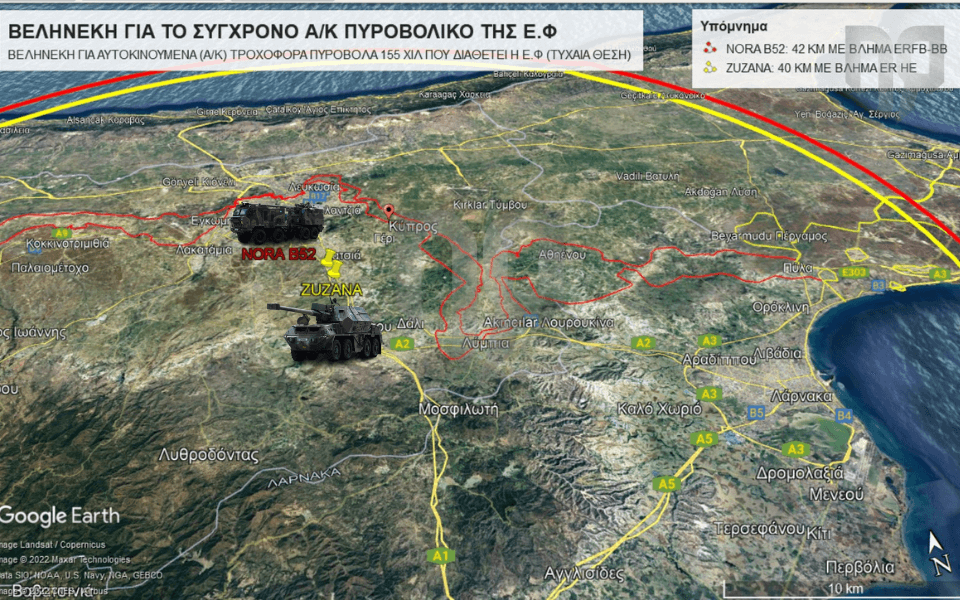
Also read: National Guard | Arrival of the 2nd squadron of 155mm NORA B52 self-propelled guns Photos & VIDEO
Even today, no international organization (e.g. the OSCE) has been allowed to record in detail the personnel, equipment and infrastructure that the Turkish forces established in the occupied areas. It is noted that occupied North Cyprus is considered one of the most militarized regions on the planet, taking into account the total area and the number of forces ratio.
It is estimated that Turkey’s military force in occupied Cyprus today amounts to 34,000 soldiers. Another 3,500 Turkish Cypriots of the so-called “Security Forces Command” can be added. In addition, in full mobilization of reserves from the pseudo-state another 26,000 men are taken into account.
Organization
The so-called “Turkish Peacekeeping Forces Command in Cyprus” (Kıbrıs Türk Barış Kuvvetleri Komutanlığı: KTBK) based in occupied Kyrenia is a Major Army Corps level formation, directly under the command of the Turkish Land Forces Command (GDF). The current commander is Major General Yilmaz Yildirim.
The Turkish occupying troops (of the so-called Turkish Cyprus Peacekeeping Force), which are in offensive formation, keep a high percentage of staffing and are organized as below:
- The Headquarters of the Turkish “Peacekeeping” Cyprus Force which, as mentioned above, is of Army Corps level and based in Kyrenia.
- The 28th Mechanized Infantry Division based in Assia and Zone of Responsibility from Geri to Deryneia (east of the Ceasefire Line). Under the command of the 28th Mechanized Infantry Division are the 230th Mechanized Infantry Regiment based in Tympou, the 28th Mechanized Infantry Regiment based in Marathovounos, the 61st Infantry Regiment based in Tremetousia and the 28th Artillery Regiment based in Assia.
- The 39th Mechanized Infantry Division based in Myrtou and has a Zone of Responsibility from Agios Vasilios to Pyrgos Tillirias (west of the Ceasefire Line) with the 14th and 50th Mechanized Infantry Regiments in Pentageia and Skylloura respectively, the 49th Infantry Regiment in Kato Zodia and the 39th Artillery Regiment in Agios Vasilios.
Also read: ACV | The Turkish Infantry and Armored Fighting Vehicles during exercises in occupied Cyprus
- The 14th Armored Brigade based in Kythrea, consisting of 3 Tank Battalions with various types of tanks (M48A5T1-T2, Leopard 2A4**), 1 Mechanized Infantry Battalion and 1 Self-propelled Artillery Battalion.
- The Security Forces Command (Güvenlik Kuvvetleri Komutanlığı: GKK) also known as the Turkish Cypriot Force with the size of a Division based in Bogazi. It was established in 1976 and includes 4 Infantry Regiments manned by Turkish Cypriots as well as the “Security Corps” of the pseudo-state.
- A Special Forces Regiment based in Halevka and the 109th Artillery Regiment based in Agyrta.
- The Logistics Command based in Kato Dikomo, responsible for the units with fuel and ammunition depots. Through the said Command, there is also control of the occupied ports of Famagusta, Kyrenia, Karavostasi and the airports of Lefkoniko, Tympou and Krini (where the headquarters of the Army Aviation Company is located). Furthermore, the Command controls the air and sea surveillance systems with facilities in Pentadaktylos (Profitis Ilias, Kantara) and Kormakitis.
- The Coast Guard Command with a number of patrol boats (around 10).
It is noted that the naval and air infrastructures that have been built after 1974 in the occupied territories allow the rapid transfer of a large number of military personnel and equipment from the bases of the southern and southeastern regions of Turkey, in order to maintain and support their forces in Cyprus.
INTERACTIVE MAP: (MAP CURRENTLY UPDATING – THE URL IS TEMPORARLY NOT WORKING)

Turkish Occupying Forces Equipment
The Turkish Occupying Forces (TOC) main equipment is:
Battle Tanks
- 42 x Leopard 2A4 with 120 mm cannon. **More recent information from the SIGMA TV station (28/03/2023) reports that the 42 tanks were withdrawn in March 2021. The tanks arrived in Cyprus in November 2018. Their withdrawal cannot be confirmed nor denied. Our assumption is that they might have been sent to Turkey temporarily in order to be upgraded.

- 300 x M48A5T1/T2 with 105 mm gun
 M48A5T2 during a parade in the Occupied AreasArmored Vehicles
M48A5T2 during a parade in the Occupied AreasArmored Vehicles
Armored Vehicles
- Infantry Fighting Vehicles (IFVs):
- 147 x ACV- AIFV
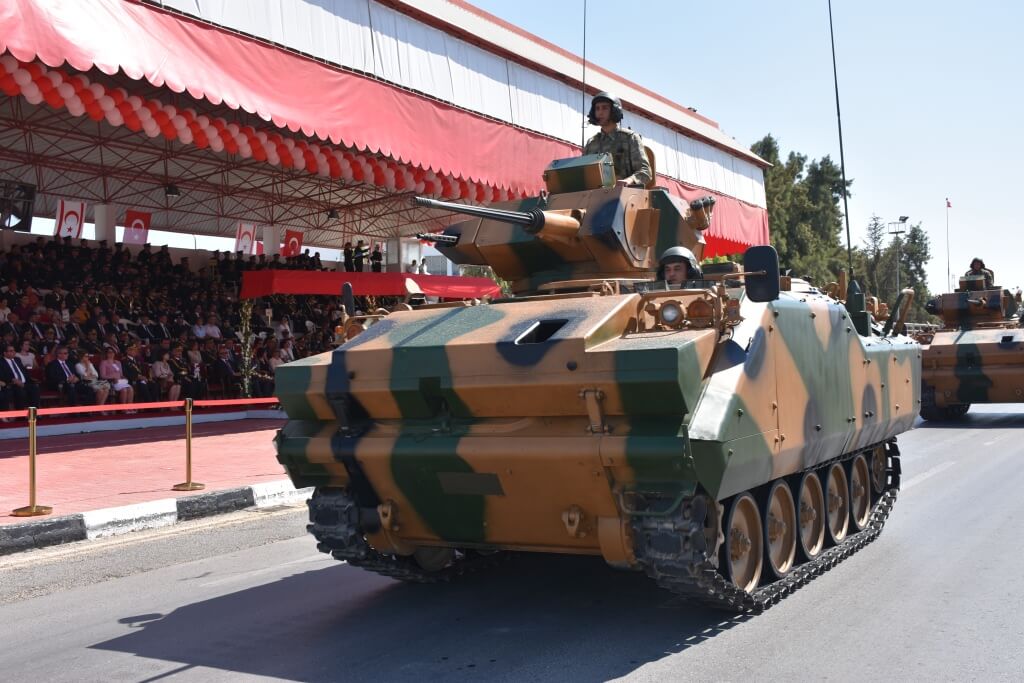 ACV-AIFV during a parade in the Occupied Areas
ACV-AIFV during a parade in the Occupied Areas
- Armored Personnel Carriers (APVs):
106 x ACV-AAPC (various versions)
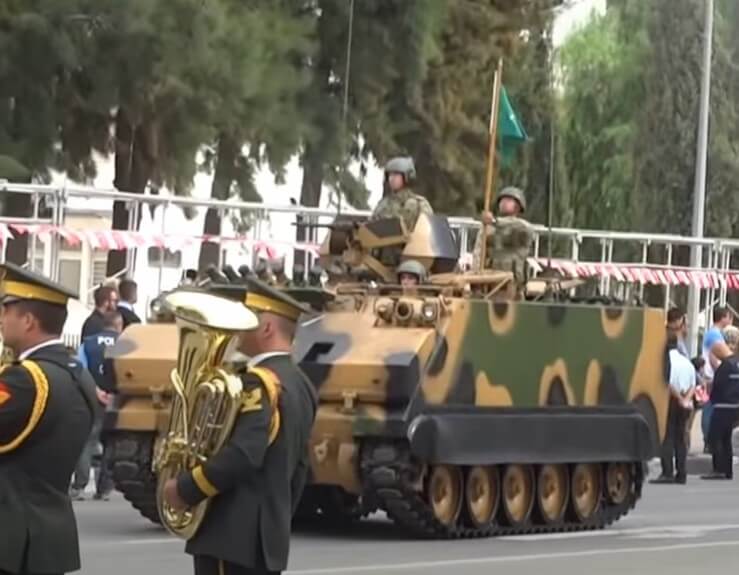 ACV 15-AAPC during a parade in the Occupied Areas
ACV 15-AAPC during a parade in the Occupied Areas
- 386 x M113 APC (various versions)
- TOW Anti Tank Guided Missile (ATGM) carriers: 60 x ACV TOW
 ACV-ATV during a parade in the Occupied Areas
ACV-ATV during a parade in the Occupied Areas
- OMTAS ATGM Carriers: 4 x PARS
 PARS 4X4 with OMTAS anti-tank missiles (file image – see interactive map for illustration in exercise)
PARS 4X4 with OMTAS anti-tank missiles (file image – see interactive map for illustration in exercise)
Wheeled Vehicles
- Machine Gun (7.62mm)/AGS-17 Grenade Launcher carriers (on Akrep vehicles)
 Akrep vehicles during a parade in the Occupied Areas
Akrep vehicles during a parade in the Occupied Areas
- 0.50″/AGS-17/ATGM Konkurs-M on Engerek vehicles
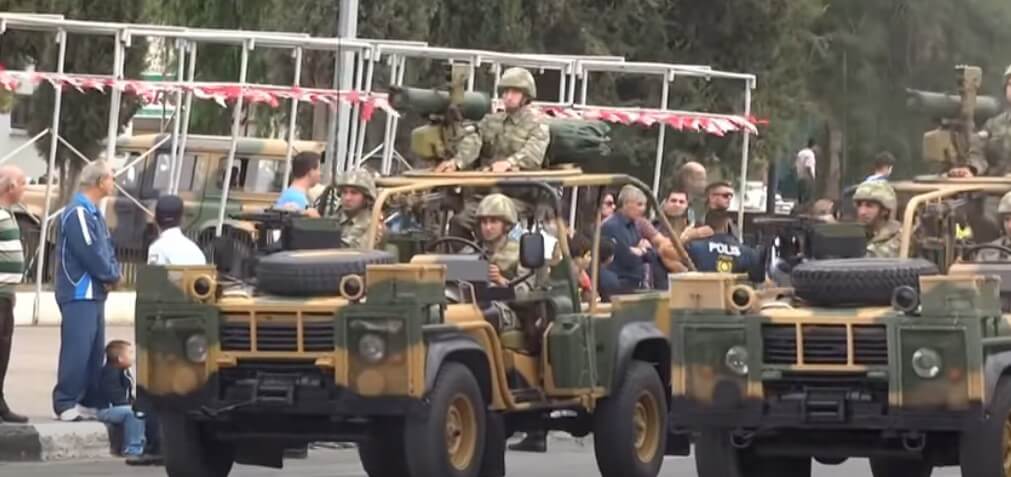 ATGM Konkurs-M mounted on Engerek vehicles during a parade in the Occupied Areas
ATGM Konkurs-M mounted on Engerek vehicles during a parade in the Occupied Areas
Self-propelled howitzers:
- 20 x Firtina T-155/155mm
- 144 x M52T1/155mm
- 30 x M44T/155mm
 M52T1 155mm during an exercise in the Occupied Areas
M52T1 155mm during an exercise in the Occupied Areas
Towed artillery:
- 12 x M115/203 mm
- 36 x M114A2/155 mm
- 36 x M101A1/105 mm
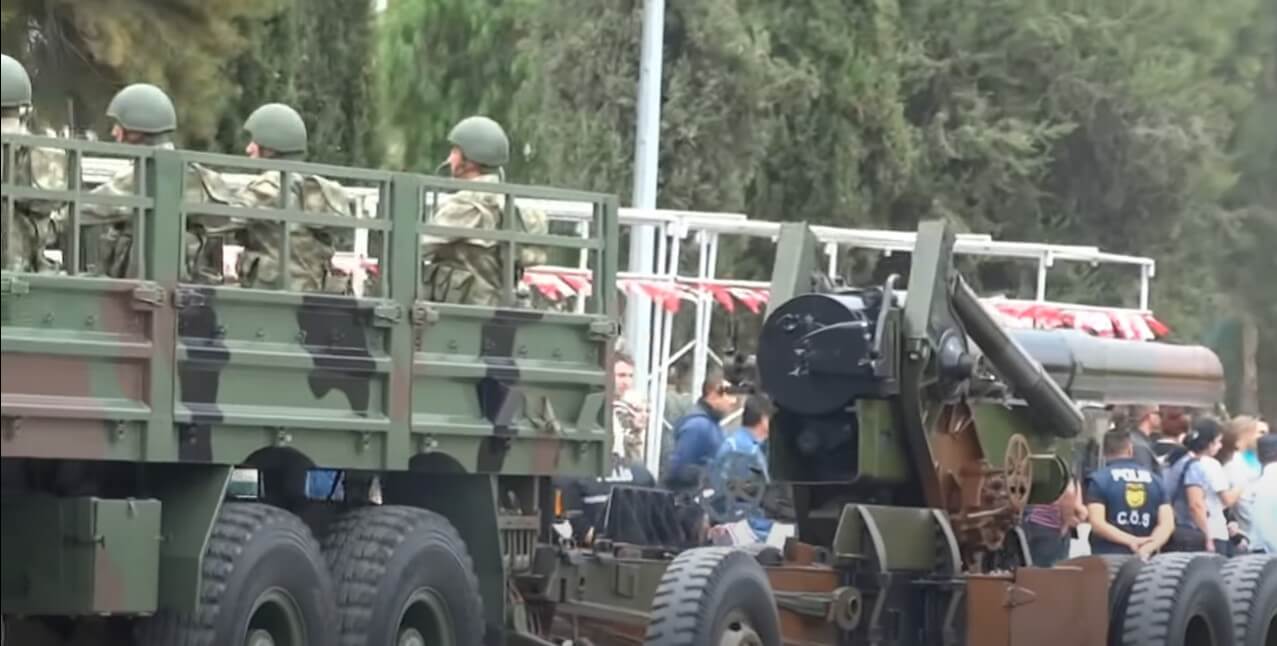 M115 during a parade in the Occupied Areas
M115 during a parade in the Occupied Areas
Multiple Rocket Launcher Systems (MLRS)
- 18 x T-122 Sakarya/122 mm
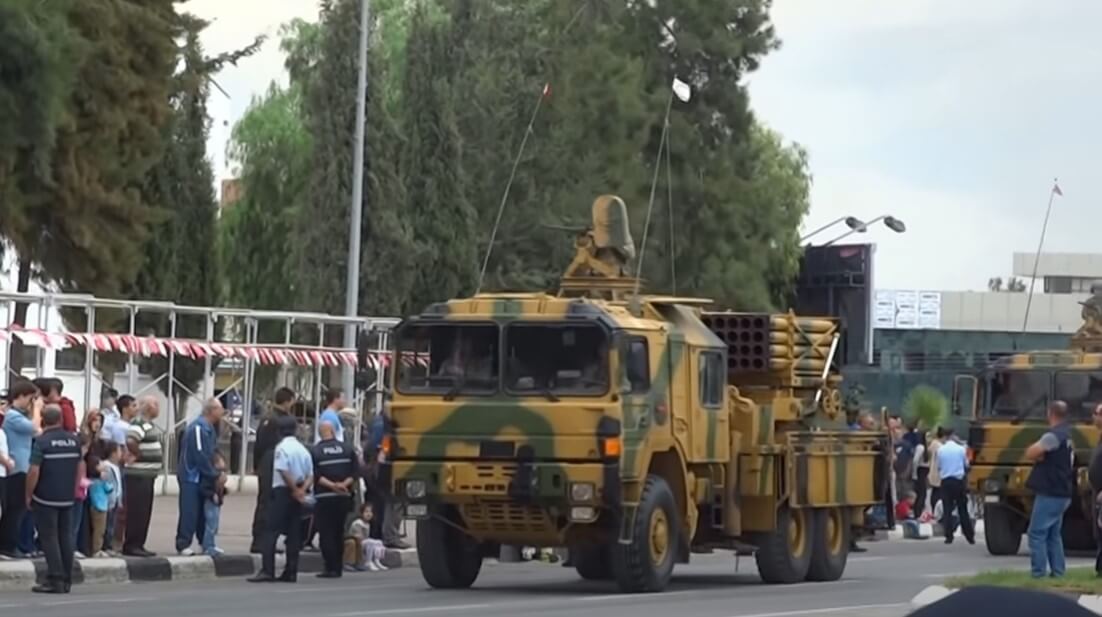 T -122 Sakarya during a parade in the Occupied Areas
T -122 Sakarya during a parade in the Occupied Areas
Mortars
- 135 x HY-12/120 mm + an addiotional 73/120 mm (Under the control of GKK)
- 70 x M30/107 mm (4.2″)
- 171 x 81 mm
- 60 mm Commando (unknown number)
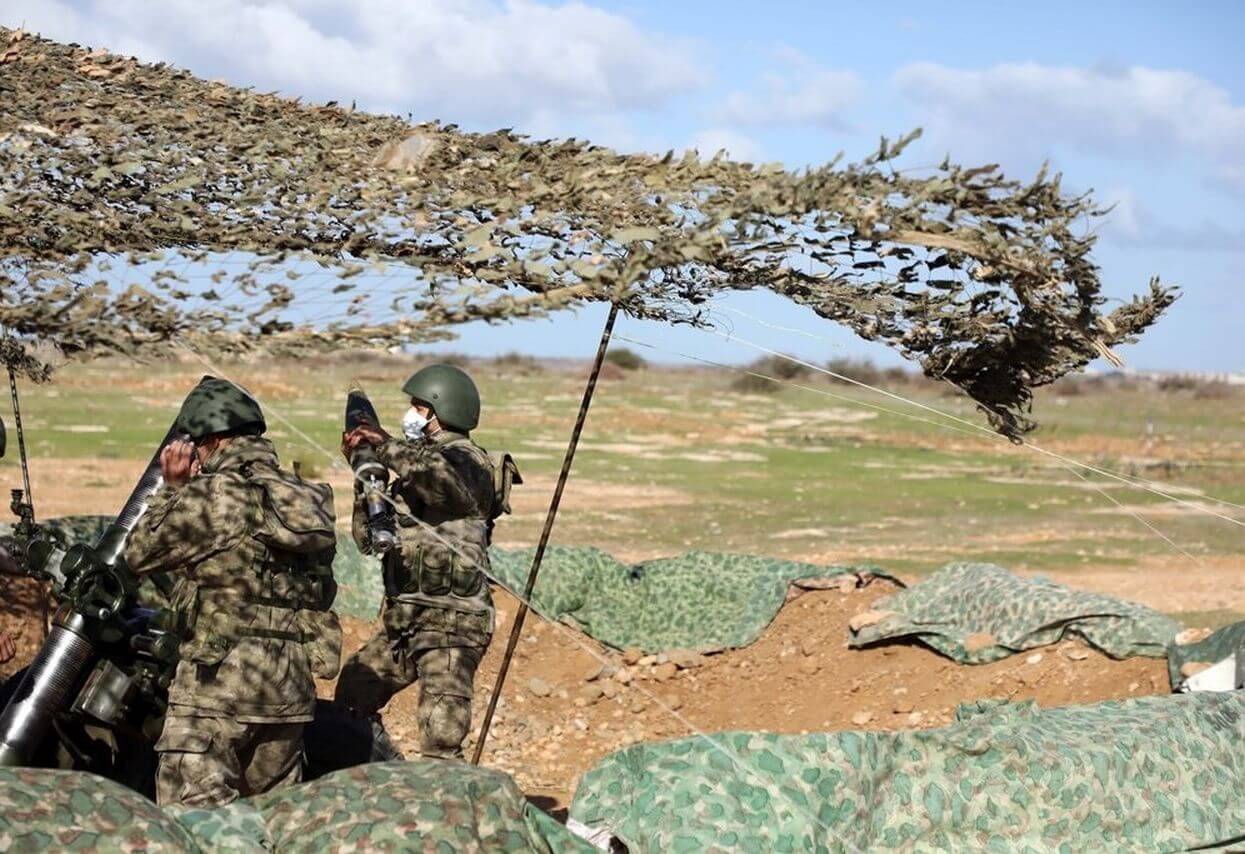 120mm-mortar-1024×702
120mm-mortar-1024×702
Anti-Tank Guided Missile Systems (ATGMs):
- 72*** x 9M113M Konkurs-M
- 72*** x MILAN
- 48*** x TOW / ERYX
***Estimated numbers
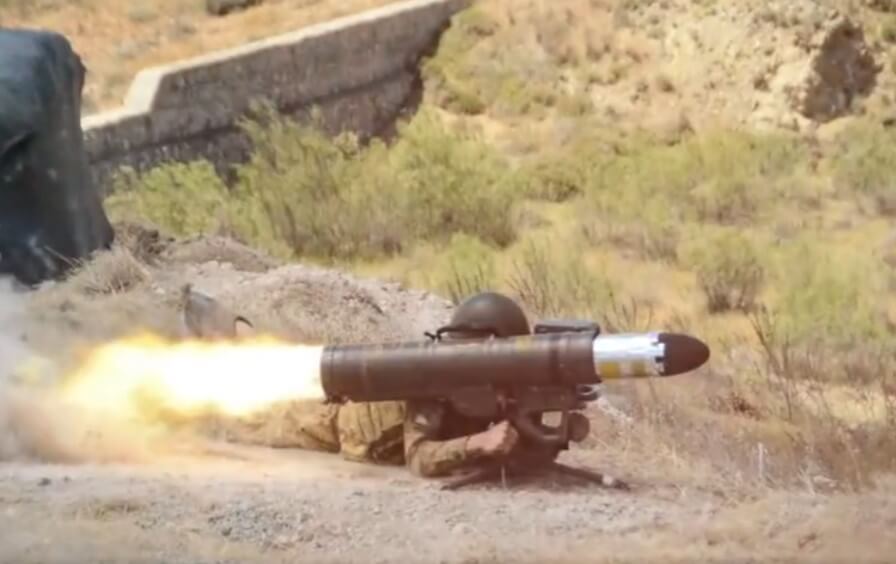 ERYX ATGM firing during an exercise in the Occupied Areas
ERYX ATGM firing during an exercise in the Occupied Areas
Recoilless Cannons:
- 219 x M40A1/106 mm + 36 M40A1 /106 mm (Under the control of GKK)
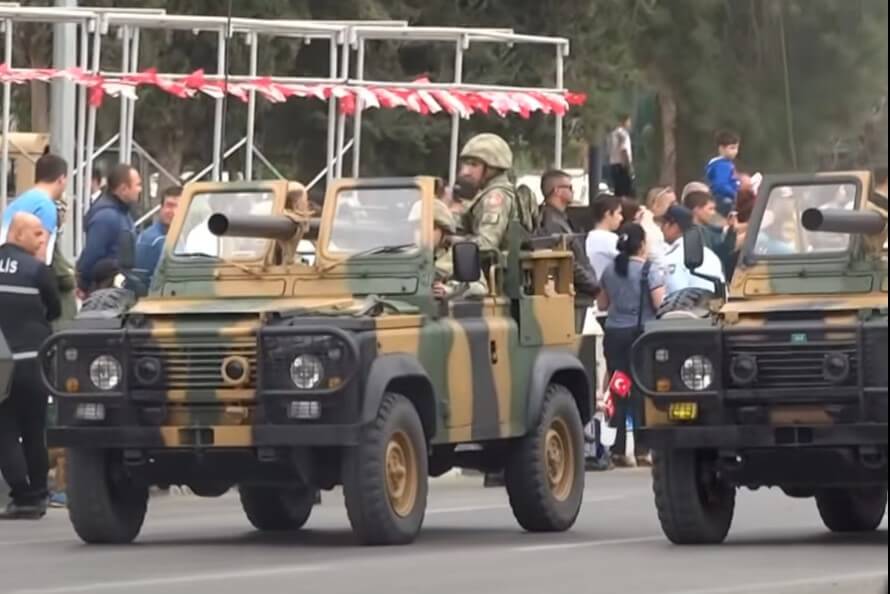 M40A1 during a parade in the Occupied Areas
M40A1 during a parade in the Occupied Areas
Mine Removal Systems
- TAMKAR: Unknown number
 TAMKAR during an exercise of the Infantry Battalion of the 28th Regiment in May 2022 in the Occupied Areas
TAMKAR during an exercise of the Infantry Battalion of the 28th Regiment in May 2022 in the Occupied Areas
Air Defence Systems
Manpads (Portable)
- 170**** x FIM 92 Stinger
****Estimation
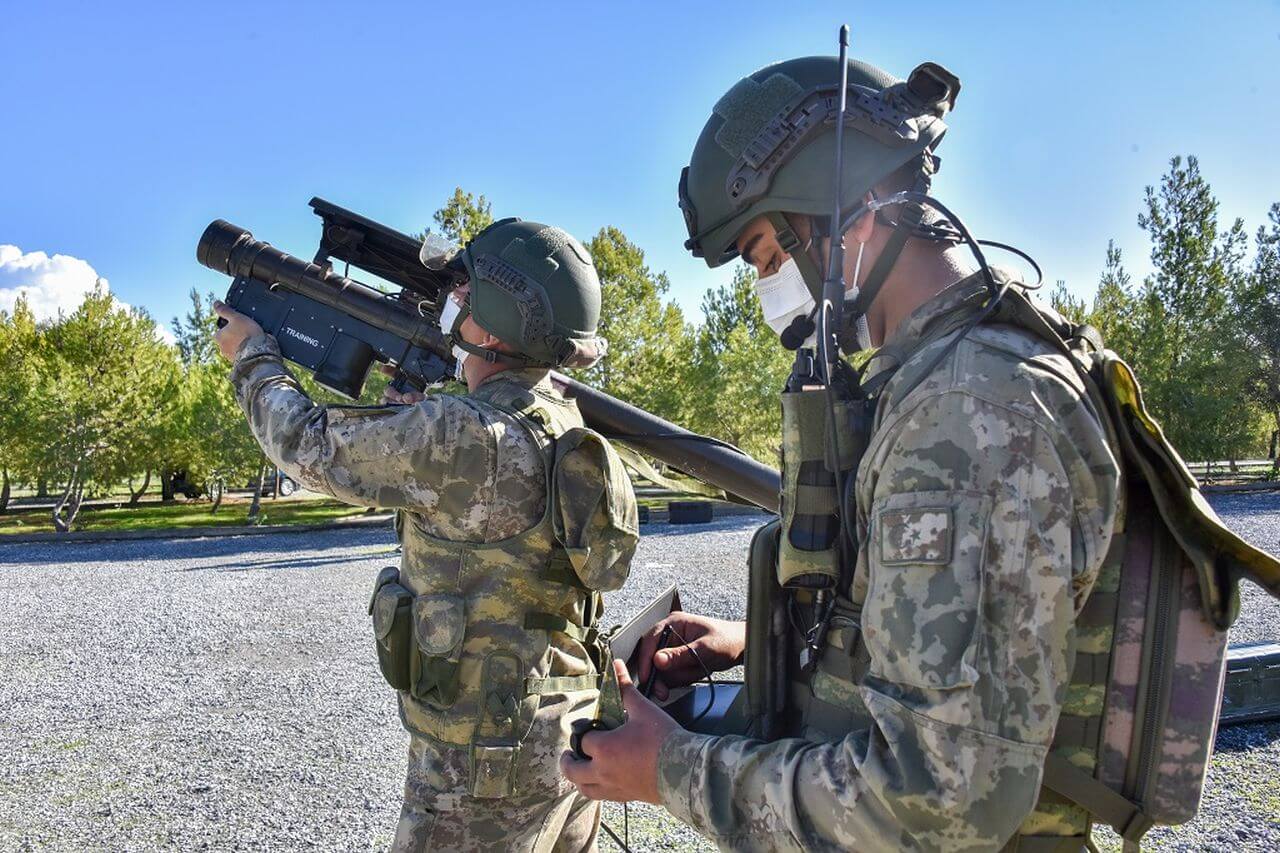 FIM-92 Stinger during a simulation exercise in the Occupied Areas
FIM-92 Stinger during a simulation exercise in the Occupied Areas
Also read: FIM-92 STINGER | Its use by the Turkish army in occupied Cyprus
Towed Anti Aircraft Artillery (AAA)
- 28 x GDF-003 / 35 mm
- 78 x GAI-D01 / 35 mm
- 122 x Mk20 Rh202 / 20 mm
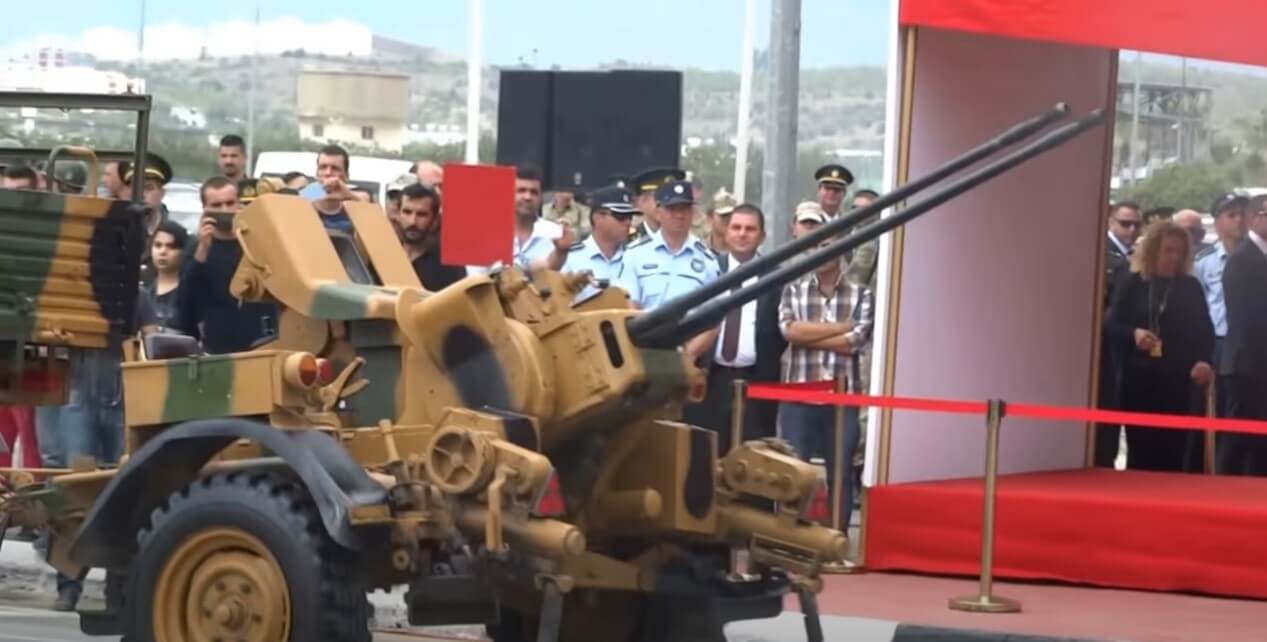 Mk20 Rh202 / 20 mm during a parade in the Occupied Areas
Mk20 Rh202 / 20 mm during a parade in the Occupied Areas
Aircraft
Transport Helicopters
- 2 x AS532UL Cougar
- 1 x Bell 205 (UH-1H)
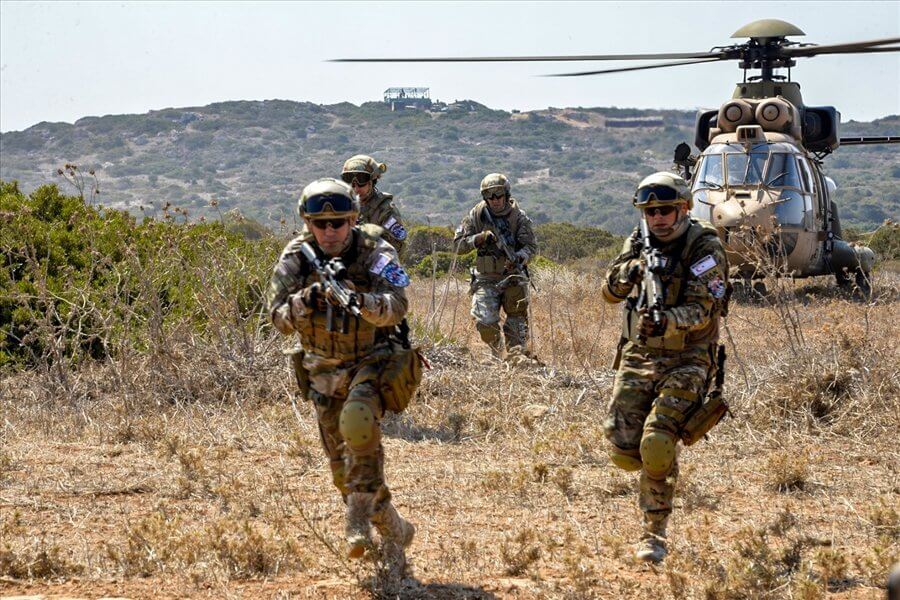 AS532UL Cougar helicopter with TOC soldiers carrying indigenous KCR 556 (5.56x45mm) rifles during an exercise in the Occupied Areas
AS532UL Cougar helicopter with TOC soldiers carrying indigenous KCR 556 (5.56x45mm) rifles during an exercise in the Occupied Areas
Bayraktar TB2/S Unmanned Aircraft
There are reports of 6 permanently stationed UCAVs Bayraktar TB2/S in occupied Cyprus.
Defence Expenditures of the Republic
In this article we will not present the equipment of the National Guard, but will only mention that the defence budget of the Republic of Cyprus for 2021 amounts to approximately € 482 million euros with expenses subdivided as follows:
- € 8,911,429 for the operational expenses of the Ministry of Defence
- €158,641,093 for the payroll needs of Permanent Officers and Non-Commissioned Officers as well as the payment of various allowances (Cyprus Army)
- €165,843,579 for the expenses of the National Guard (Contract Soldiers, salaries, conscripts, maintenance) and
- €148,983,844 for the Defence Fund (procurement, modernization, maintenance of weapon systems, execution of projects related to military installations).
According to a document of the General Accounting Office, between 1984 – when the extraordinary contribution for Defence was first paid – and 2016, sums of €8 billion had been collected, of which only €4.5 billion were allocated to the Defence Fund. The funds were used to cover the modernization needs of the Defence Forces and the remaining €3.5 billion were used for general payroll needs in the public sector and other non-defence related expenses.
*Journalist – Analyst
Sources:
-defenceredefined.com.cy
– Hellenic Ministry of Foreign Affairs – https://www.mfa.gr/
– Republic of Cyprus Ministry of Foreign Affairs https:/ /mfa.gov.cy/
– https://isozygio.wordpress.com/
-The Military Balance 2021
-ONISILOS – https://www.onisilos.gr/
**The opinions and/or comments expressed in the articles belong to each author and may not constitute an opinion and/or position and/or be adopted as such by the company and/or website administrators. More info can be found in the terms of use of the website.
READ MORE
The role of SERIOUS GAMES in the development of skills on Defense Standards
In an increasingly complex world, one vital factor for any successful organization is continuous capability building.
Strategy for Building Up Interoperable Defence Capabilities
Based on the current and emerging security threats and challenges in the geostrategic landscape, there is a…
HNDGS | Bilateral joint training between Greece and Poland – Photos
The bilateral joint training between the Armed Forces of Greece and Poland, in the wider area of Attica, was completed on Thursday…
Sielman | Contract for support of the HAWK anti-aircraft system
The US Department of Defence has awarded a $49.9 million contract modification to Greek company Sielman S.A. to provide diagnostic and…
Hellenic Entrepreneurs Association | Ideas & Positions for the Promotion of Greek Entrepreneurship
The members of the Hellenic Entrepreneurs Association (E.E.N.E.) participated in a roundtable discussion entitled “Ideas, Positions…
Ukraine | Increase in defence spending by 367 million euros for the acquisition of drones
Kiev is increasing spending by 15.5 billion hryvnias (367 million euros) to bolster Ukraine’s armed forces with drones, according to…
HMoND | The legislative initiative for HCDI is under consultation
The legislative initiative of the Ministry of National Defence, under the title: “Establishment of the Hellenic Center for Defence…
Russia | Cluster bombs hit residential area in Odessa
Images from Russia’s strike in the heart of Odessa, which hit the so-called “Harry Potter Castle”, a former politician’s mansion now…








